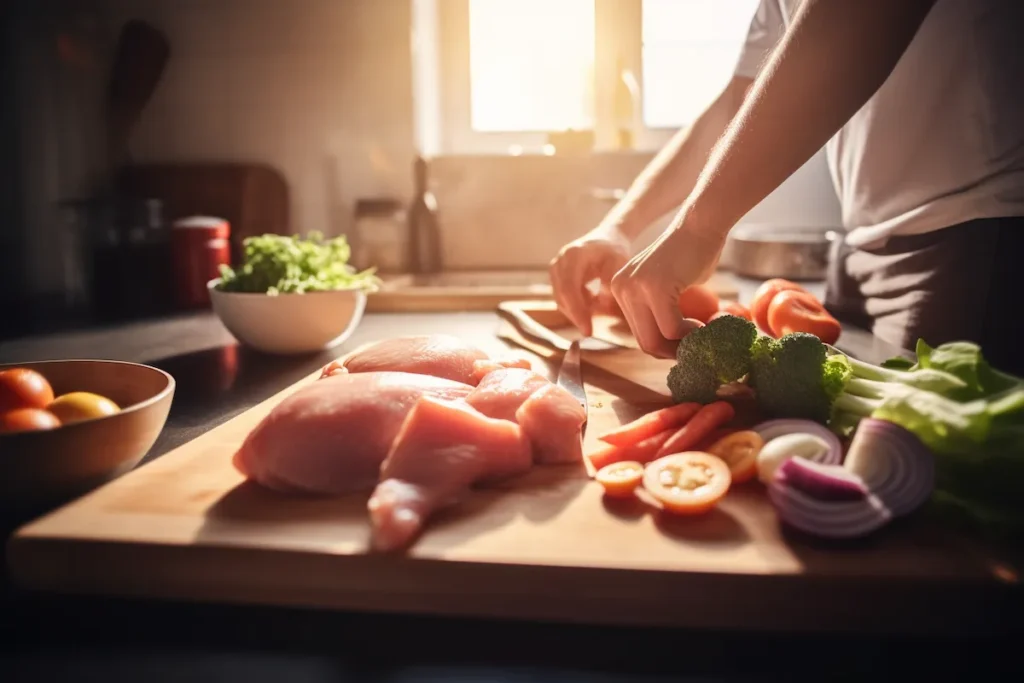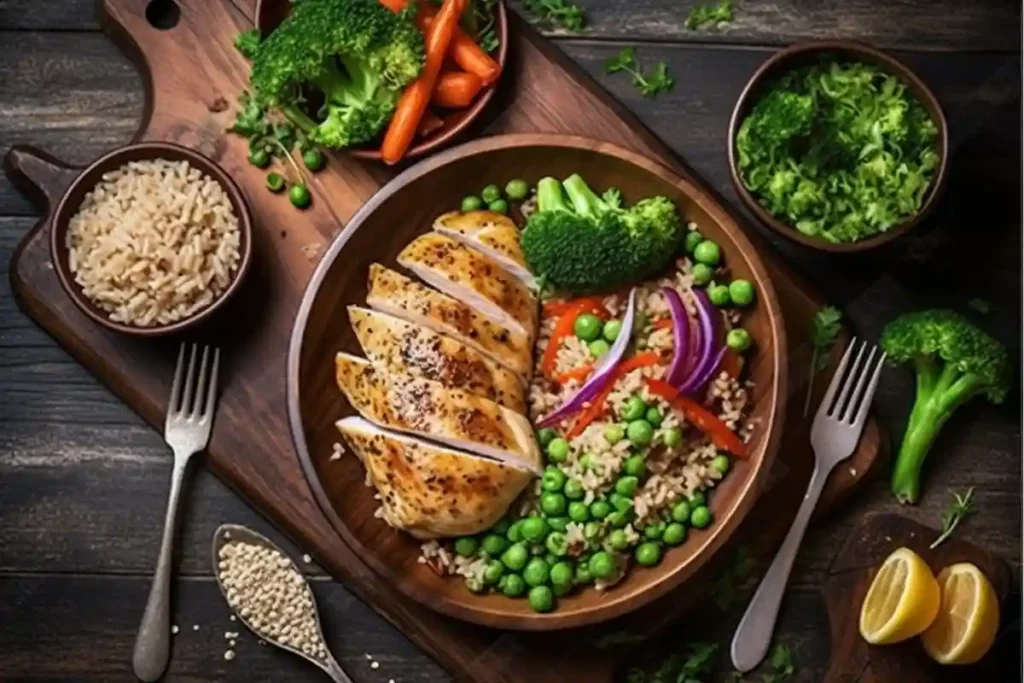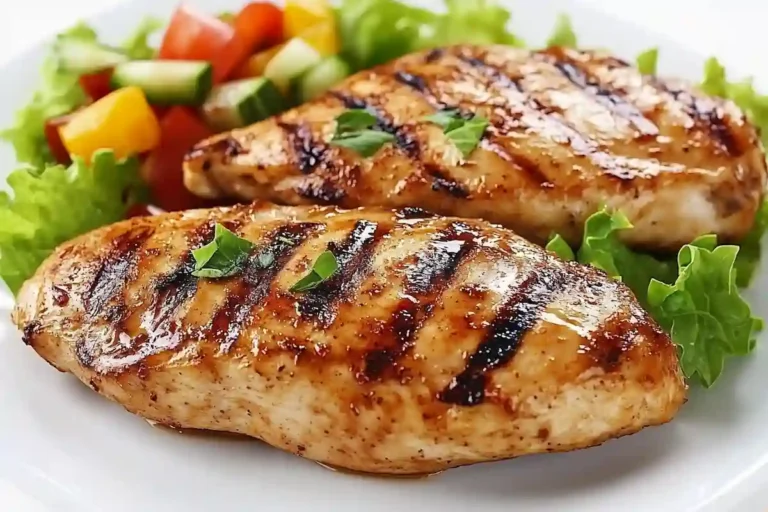Introduction
When it comes to protein-packed foods, chicken breast is a top choice for anyone focused on fitness and muscle development. However, how many chicken breasts per day to build muscle remains a common question among beginners and experienced lifters alike. This guide will help you determine the optimal daily intake of chicken breasts for maximizing your gains, offering practical strategies to meet your protein targets and ensure steady progress.
1. Why Is Protein From Chicken Breast Important for Muscle Building?
Before diving into how many chicken breasts per day to build muscle, it’s vital to understand why protein itself is essential. Protein supplies the amino acids your body needs to repair and grow muscle tissue. During resistance training, muscle fibers experience micro-tears, and protein helps rebuild these fibers stronger than before.
Chicken breast stands out because it’s lean, meaning it delivers a high-quality protein punch without excessive fat or calories. When determining how many chicken breasts per day to build muscle, remember that the quality of the protein source matters just as much as the quantity. Chicken breast provides all the essential amino acids necessary for recovery and growth.
2. How Many Chicken Breasts Per Day to Build Muscle?
To figure out how many chicken breasts per day to build muscle, you first need to determine your total daily protein requirement. Most fitness experts suggest 1.6 to 2.2 grams of protein per kilogram of body weight for those aiming to add muscle mass.
- 70 kg individual: 112–154 grams of protein per day
- 80 kg individual: 128–176 grams of protein per day
- 90 kg individual: 144–198 grams of protein per day
On average, one 100-gram serving of skinless, boneless chicken breast contains around 31 grams of protein. A medium chicken breast weighing roughly 200 grams packs about 62 grams of protein.
- 70 kg (154 lbs): About 2 to 2.5 chicken breasts per day (400–500 g total)
- 80 kg (176 lbs): About 2.5 to 3 chicken breasts per day (500–600 g total)
- 90 kg (198 lbs): About 3 to 3.5 chicken breasts per day (600–700 g total)
These numbers offer a solid starting point for deciding how many chicken breasts per day to build muscle based on body weight. Adjust slightly for activity level, workout intensity, and individual metabolism.
3. Key Benefits of Eating Chicken Breast for Muscle Growth

- Lean Protein Source
Chicken breast is high in protein and low in fat, which makes it an excellent choice for muscle building while keeping calorie intake in check. - Rich in Vitamins and Minerals
B vitamins (like niacin and vitamin B6), which support energy metabolism and immune function, are abundant in chicken breast. This vitamin profile helps you stay energized and healthy during intense training phases. - Low in Calories
Because it’s low in fat, chicken breast fits easily into a balanced meal plan. Maintaining the right caloric balance is critical for gaining lean muscle without excess body fat.
4. Structuring Your Meals: Practical Ways to Include Chicken Breast
Knowing how many chicken breasts per day to build muscle is one thing; effectively incorporating them into your meal plan is another. Here are some tips:
- Distribute Protein Throughout the Day
Instead of eating all your chicken at once, spread out your protein sources. Aim for 4–5 evenly spaced, protein-rich meals. For example:- Breakfast: Eggs or a protein shake
- Lunch: Grilled chicken breast with veggies and brown rice
- Snacks: Greek yogurt, cottage cheese, or smaller chicken portions
- Dinner: Chicken breast with sweet potato or quinoa
- Choose Healthy Cooking Techniques
- Grilling: Adds flavor without excess oil
- Baking: Retains moisture with minimal added fats
- Poaching: Keeps chicken moist and low in added calories
- Rotate Flavors and Seasonings
Use different herbs, marinades, and spices to keep meals interesting. Lemon-pepper, garlic-herb, and smoky paprika are all flavorful yet low-calorie options.
5. Can You Eat Too Many Chicken Breasts in a Day?
While chicken breast is a fantastic protein source, overdoing it can pose some concerns:
- Excess Protein Intake
Consuming too much protein may strain the kidneys over time, particularly if you have underlying health issues. Always balance protein intake with adequate amounts of fruits, vegetables, and whole grains. - Limited Dietary Variety
Relying solely on chicken breast can lead to nutrient gaps. Mix up your protein sources—consider fish, lean beef, eggs, or plant-based proteins like beans and lentils. - Potential Caloric Surplus
Even lean protein has calories. Eating more chicken than your body needs can result in unwanted weight gain if you’re not training intensely or tracking overall caloric intake.
6. Calculating How Many Chicken Breasts Per Day to Build Muscle
To finalize how many chicken breasts per day to build muscle, follow these steps:
- Convert Your Weight to KilogramsWeight in kg=Weight in pounds2.205Weight in kg=2.205Weight in pounds
- Determine Total Daily Protein
Multiply your weight in kilograms by 1.6 to 2.2. An 80 kg individual would need between 128 and 176 grams of protein per day. - Divide by Protein per Chicken Breast
One medium (200 g) chicken breast contains ~62 grams of protein. For someone needing 160 grams of protein daily, that’s about 2.5 to 3 chicken breasts.
7. Diversify Protein Sources for Better Results
Even if you’ve nailed down how many chicken breasts per day to build muscle, variety is crucial:
- Fish: Tuna and salmon offer omega-3 fatty acids to reduce inflammation and support recovery.
- Eggs: Highly bioavailable protein plus healthy fats and vitamins.
- Legumes: Beans and lentils provide plant-based protein, fiber, and essential micronutrients.
- Dairy: Greek yogurt, cottage cheese, and low-fat milk supply additional protein and calcium.
Combining multiple protein sources ensures a broad spectrum of amino acids and nutrients, boosting overall health and muscle-building potential.
8. Other Nutritional Factors That Impact Muscle Growth

- Carbohydrates
Complex carbs (brown rice, whole wheat pasta, quinoa) fuel workouts and aid recovery. Pairing chicken breast with a quality carb source helps maintain energy levels. - Healthy Fats
Monounsaturated and polyunsaturated fats from avocados, nuts, and seeds contribute to hormone production, which is vital for muscle growth. - Hydration
Staying well-hydrated supports optimal performance. Water aids in nutrient delivery to muscles, helps prevent cramps, and assists with recovery. - Nutritional Content of Chicken Breast (per 100g)
Nutritional Content of Chicken Breast (per 100g)
| Nutrient | Amount |
|---|---|
| Calories | 165 kcal |
| Protein | 31 g |
| Total Fat | 3.6 g |
| Saturated Fat | 1 g |
| Carbohydrates | 0 g |
| Fiber | 0 g |
| Sugars | 0 g |
| Cholesterol | 85 mg |
| Sodium | 74 mg |
9. Optimal Timing for Eating Chicken Breast
- Post-Workout Window
Eating chicken breast within 30–60 minutes after exercise can jumpstart muscle repair. Combining protein with carbs at this time replenishes glycogen and maximizes muscle protein synthesis. - Evening Meal
Having chicken breast at dinner provides overnight muscle support. Pair it with vegetables and a slower-digesting carb to stay satiated and supply nutrients while you sleep. - Throughout the Day
Steady protein intake—chicken breast included—keeps muscle-building processes active. This approach is often more beneficial than consuming large amounts in a single meal.
10. Hydration, Sleep, and Other Lifestyle Factors
Muscle growth isn’t determined by diet alone. Beyond figuring out how many chicken breasts per day to build muscle, consider these lifestyle components:
- Hydration
- Why it matters: Adequate water intake optimizes metabolic processes, facilitates nutrient delivery to muscle cells, and aids in waste removal. Aim for 3–4 liters per day, depending on your activity level and climate.
- Sleep
- Why it matters: Most muscle recovery and growth (muscle protein synthesis) happens during deep sleep. Aim for 7–9 hours of quality sleep each night.
- Stress Management
- Why it matters: Chronic stress elevates cortisol levels, which can break down muscle tissue and impede recovery. Techniques such as meditation, yoga, and controlled breathing exercises help keep stress in check.
- Progressive Overload in Training
- Why it matters: Consistent improvement in your workouts—whether by adding weight, increasing reps, or refining technique—stimulates muscle adaptation. Without progressive overload, diet alone won’t yield significant growth.
Taking a holistic approach ensures that knowing how many chicken breasts per day to build muscle is just one piece of a bigger, more effective puzzle.
11. Advanced Tips for Tweaking Your Chicken Intake
If you’ve been training and sticking to a nutritional plan for a while, you might look for small tweaks to improve efficiency:
- Cycling Your Protein Intake
- What it is: Alternating between slightly higher and lower protein days based on workout intensity. On heavy training days, you might consume 2.2 g/kg, and on rest days, lower it to 1.6 g/kg.
- Why it helps: This can manage calorie intake on less active days and ensure enough protein on your toughest workout days.
- Marinating for Better Nutrient Uptake
- What it is: Using acidic or enzyme-rich marinades (like pineapple juice, lemon juice, or yogurt) may help tenderize chicken and potentially improve nutrient absorption.
- Why it helps: Can lead to tastier meals, encouraging consistency and adherence to your eating plan.
- Portion Precision
- What it is: Weighing chicken breasts pre-cooking to get exact protein estimates.
- Why it helps: Over time, small discrepancies can add up. Being precise helps you stick closely to your targets, especially if you’re prepping for a physique competition or aiming for very specific results.
- Tracking Other Macronutrients
- What it is: While focusing on chicken breast, also log your carbs and fats through apps like MyFitnessPal or Cronometer.
- Why it helps: Ensures you don’t inadvertently exceed your daily calorie intake or neglect essential fats.
Utilizing these advanced techniques refines your approach to how many chicken breasts per day to build muscle, allowing for better adaptation and long-term progress.
12. FAQs About How Many Chicken Breasts Per Day to Build Muscle
- How many chicken breasts per day to build muscle if I weigh 80 kg?
Aim for 2.5 to 3 chicken breasts daily (about 500–600 grams), providing roughly 125–186 grams of protein. - Is eating 2 chicken breasts a day enough for muscle growth?
For many people, yes. Two chicken breasts can deliver over 100 grams of protein, which often satisfies a significant portion of daily needs for muscle repair. - Can I eat 200 grams of chicken breast daily and still gain muscle?
Absolutely. Two hundred grams of chicken breast offers around 62 grams of protein. Depending on your weight, you may need additional protein sources throughout the day. - Will I gain muscle by eating chicken every day?
As long as you combine consistent chicken breast intake with weight training, sufficient overall protein, and balanced nutrition, daily chicken consumption can support muscle gains.
Conclusion
The core answer to how many chicken breasts per day to build muscle typically falls in the 2–3 chicken breasts range for most individuals weighing between 70–90 kg. Of course, these numbers vary based on your exact weight, activity level, and overall dietary composition. The real power of chicken breast lies in its lean protein profile, which supports muscle repair and growth without burdening you with excessive calories or saturated fats.
Even if chicken breast is your main protein staple, remember that a holistic approach drives the best results. Combine high-quality protein with adequate carbohydrates, healthy fats, vitamins, and minerals for sustained energy, improved recovery, and balanced nutrition. Pair this with a progressive, well-structured training program, sufficient sleep, and stress management techniques to optimize your muscle-building journey.
Ultimately, no single food source—or even a single macronutrient—holds the entire key to building muscle. Yet, knowing how many chicken breasts per day to build muscle can serve as a reliable cornerstone of your meal plan. By staying patient, adaptable, and open to adjusting portion sizes based on progress and personal needs, you’ll find yourself on a sustainable path toward your fitness goals. With consistency and proper planning, how many chicken breasts per day to build muscle will no longer be a question but a well-integrated part of your nutrition strategy.
Print
High-Protein Garlic Herb Chicken Breast
- Total Time: Approximately 1 hour (including minimum marinating time)
- Yield: 4 servings 1x
Description
This High-Protein Garlic Herb Chicken Breast is a lean and flavorful dish, perfect for those aiming to build muscle. Seasoned with a blend of herbs and cooked to perfection, it provides a substantial protein boost without excess fat. Ideal for meal prep or a quick dinner, this recipe ensures you meet your nutritional goals deliciously.
Ingredients
- 4 boneless, skinless chicken breasts (approximately 200g each)
- 2 tablespoons olive oil
- 3 cloves garlic, minced
- 1 teaspoon dried thyme
- 1 teaspoon dried rosemary
- 1 teaspoon dried oregano
- 1 teaspoon salt
- 1/2 teaspoon black pepper
- Juice of 1 lemon
- Fresh parsley, chopped (for garnish)
Instructions
- Prepare the Marinade: In a small bowl, combine olive oil, minced garlic, dried thyme, rosemary, oregano, salt, black pepper, and lemon juice.
- Marinate the Chicken: Place the chicken breasts in a resealable plastic bag or a shallow dish. Pour the marinade over the chicken, ensuring each piece is evenly coated. Seal or cover and refrigerate for at least 30 minutes, preferably up to 2 hours.
- Preheat the Oven: Set your oven to 400°F (200°C) to preheat.
- Sear the Chicken: Heat a large oven-safe skillet over medium-high heat. Add a drizzle of olive oil. Remove the chicken from the marinade, allowing excess to drip off, and place in the hot skillet. Sear each side for about 2 minutes until golden brown.
- Bake: Transfer the skillet to the preheated oven. Bake for 15-20 minutes, or until the internal temperature of the chicken reaches 165°F (74°C).
- Rest and Serve: Remove the skillet from the oven and let the chicken rest for 5 minutes. Garnish with freshly chopped parsley before serving.
Notes
- Meal Prep Tip: Cooked chicken breasts can be stored in an airtight container in the refrigerator for up to 4 days, making them ideal for meal prepping.
- Serving Suggestions: Pair with steamed vegetables, quinoa, or a fresh salad for a balanced meal.
- Flavor Variations: Feel free to adjust the herbs and spices to your preference. Adding a pinch of red pepper flakes can introduce a subtle heat to the dish.
- Prep Time: 10 minutes
- Marinating Time: 30 minutes to 2 hours
- Cook Time: 25 minutes
- Category: Lunch
- Method: Baking
- Cuisine: American
Nutrition
- Serving Size: 1 chicken breast
- Calories: 280
- Sugar: 0g
- Sodium: 620mg
- Fat: 7g
- Saturated Fat: 1.5g
- Carbohydrates: 2g
- Fiber: 0.5g
- Protein: 53g
- Cholesterol: 145mg
Keywords: Chicken Breast, High-Protein, Muscle Building, Healthy Dinner, Meal Prep

